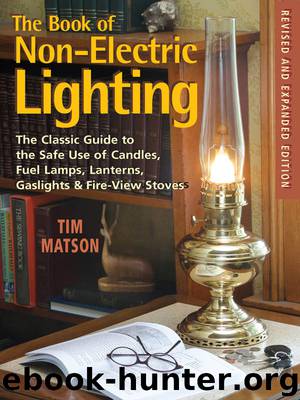The Book of Non-electric Lighting: The Classic Guide to the Safe Use of Candles, Fuel Lamps, Lanterns, Gaslights & Fire-View Stoves by Tim Matson

Author:Tim Matson [Matson, Tim]
Language: eng
Format: azw3
Publisher: Countryman Press
Published: 2011-11-27T16:00:00+00:00
A Coleman can be a farmer’s best friend during a power outage.
Safe Handling
There are two types of Coleman pressure lanterns—gasoline and kerosene. Both are fundamentally similar, incorporating hand-pressurized fuel tanks and one or two mantles. But each fuel demands its own distinct ignition procedure. The gasoline lantern offers the easiest start-up, but because of the highly flammable fuel it calls for the most cautious handling. The kerosene lantern is the trickiest to light, but the low flash point of the fuel makes it the safest. Illumination is slightly higher with the gasoline double-mantle lantern; the cost per hour is slightly lower for the single-mantle kerosene lanterns.
It is absolutely crucial to know what you’re doing when you operate a Coleman lantern. The combination of pressurized flammable fuel—especially gasoline—and a tricky ignition procedure that often involves a momentary burst of flame may cause injury or property damage if you do not follow instructions. The instruction pamphlets provided with each lantern all begin with boldface warnings, which can be condensed as follows:
• Do not use in unventilated areas.
• Use for lighting only.
• Never fill lantern or loosen or remove fuel cap while lantern is lighted, near flames or other ignition sources, or while top of lantern is hot to touch.
• Never allow any flammable material to come within 2 feet of the top and 1 foot of the side of the lantern.
• Replace any mantle with a hole in it.
• Never adjust light output with fuel valve or cleaning lever.
• Keep out of reach of children.
• In the case of gasoline lanterns, use only Coleman fuel or clean, fresh white gas. Never use fuel containing lubricating oils, lead compounds, or other metallic compounds. (Some unleaded automotive fuels may contain metallic compounds.) Coleman fuel is extremely flammable. Use the same care as when using gasoline.
• For kerosene lanterns, use only clean, fresh white kerosene.
Coleman makes several pressure lanterns: both double- and single-mantle gasoline burners and single-mantle kerosene lanterns. One of their most popular lanterns is the double-mantle gas model. Its 1-quart fuel capacity generates eight hours of 220 candlepower light. The lantern stands 14 inches high and weighs 5 pounds. Except for the mantles, the lantern comes pre-assembled.
Fueling
Whether you burn Coleman gas, white gas, or kerosene, it’s a good idea to get in the habit of pouring the fuel through a filtered funnel. That will minimize the buildup of deposits in the generator, which leads to lower efficiency and eventual replacement of the generator. Before filling, close both the fuel valve and the pump knob firmly. During filling, the lantern should be in a level position. Tighten the fuel cap firmly after filling, and wipe up any spilled fuel.
Mantles
Unscrew the ball nut at the top of the lantern so you can remove the ventilator top and the glass globe. Then tie the mantles on with the strings tight around the grooves in the burner caps. Distribute the folds evenly. The flat side of each mantle should face the generator. Cut off surplus string. Always
Download
This site does not store any files on its server. We only index and link to content provided by other sites. Please contact the content providers to delete copyright contents if any and email us, we'll remove relevant links or contents immediately.
| Decorating | Decoration & Ornament |
| Feng Shui | Floors |
| Interior Decorating | Lighting |
| Painting & Wallpapering | Professional Reference |
| Style | Upholstery & Fabrics |
| Windows |
The Body: A Guide for Occupants by Bill Bryson(4973)
Audition by Ryu Murakami(4840)
Adulting by Kelly Williams Brown(4485)
Housekeeping by Marilynne Robinson(4329)
Be in a Treehouse by Pete Nelson(3941)
Zero Waste Home by Bea Johnson(3777)
Seriously... I'm Kidding by Ellen DeGeneres(3574)
Better Homes and Gardens New Cookbook by Better Homes & Gardens(3524)
The Healing Self by Deepak Chopra(3473)
Barkskins by Annie Proulx(3298)
Hedgerow by John Wright(3274)
The Cellar by Natasha Preston(3259)
Spark Joy by Marie Kondo(3248)
The Genius of Japanese Carpentry by Azby Brown(3223)
The Life-Changing Magic Of Tidying Up- The Japanese Art Of Decluttering And Organizing (v5.0) by Marie Kondo(3211)
120 Days of Sodom by Marquis de Sade(3177)
Work Clean by Dan Charnas(3048)
The Book of Numbers by Peter Bentley(2907)
A Monk's Guide to a Clean House and Mind by Shoukei Matsumoto(2866)
